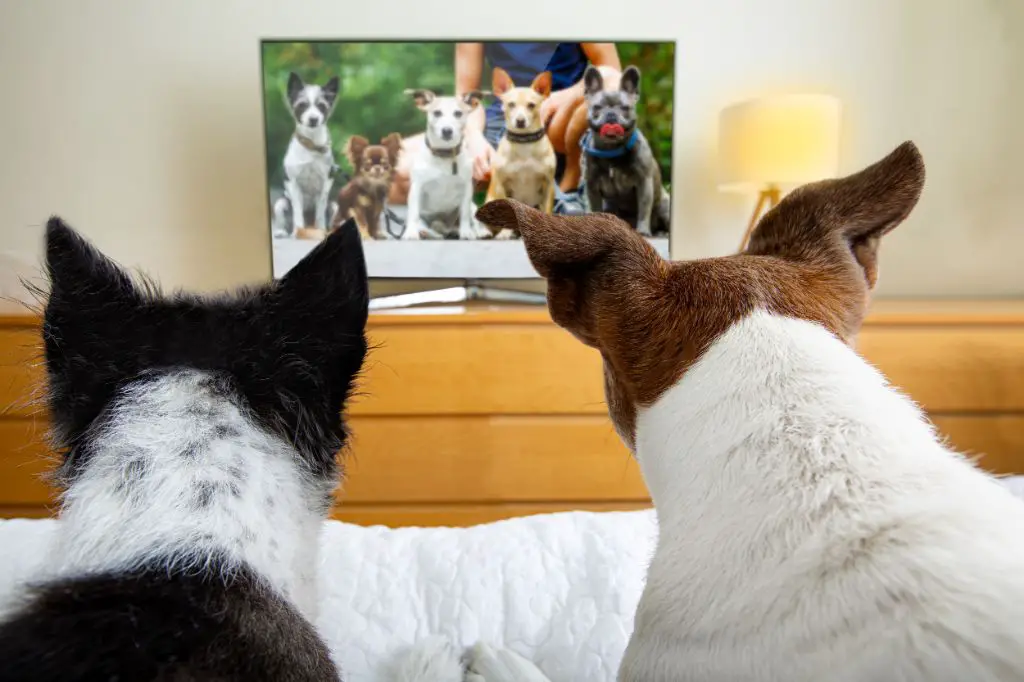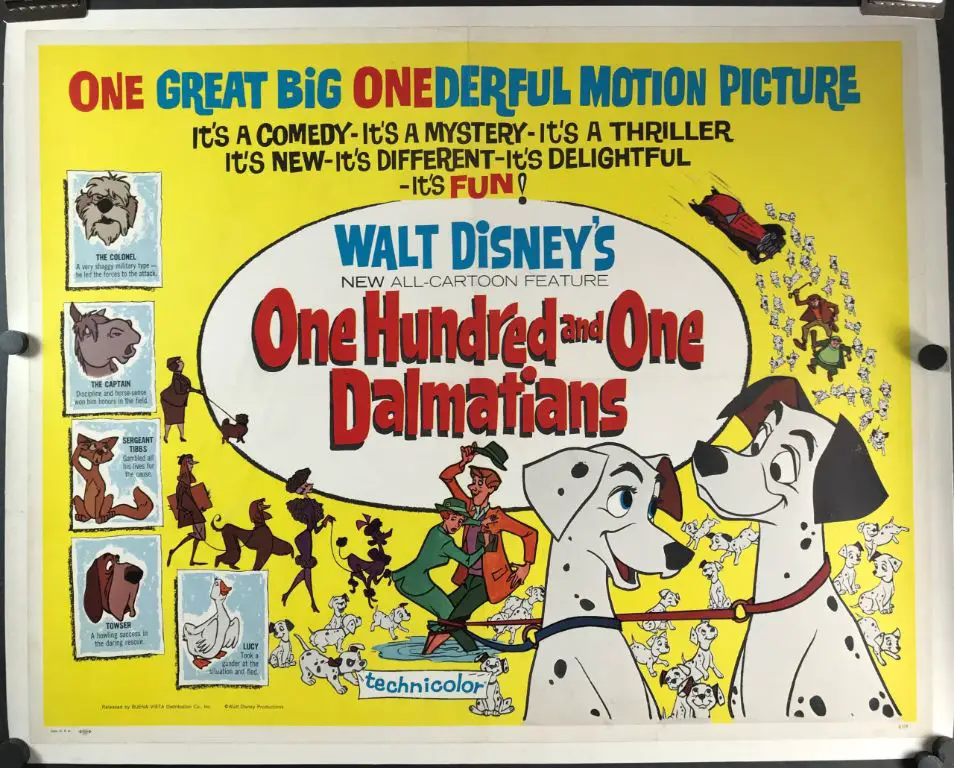Why Dogs May Enjoy Watching Movies

There are several reasons why dogs may enjoy watching movies and TV shows. A major factor is the visual and auditory stimulation that television provides. Dogs have good vision and hearing, so the moving images, changing scenes, colors, and sounds can be interesting to them (Source). Even though their vision is not as sharp as humans, dogs can clearly see things on a TV or device screen from several feet away.
The social aspects of watching with their owners can also make the activity rewarding for dogs. If their owner is focused on the TV, the dog may become curious and want to share in the experience. Dogs are pack animals and like participating in family activities (Source).
Watching movies and shows can provide mental stimulation as well. Following the characters, actions, and storylines engages a dog’s mind and natural interest. Movies with sounds of other animals, chase scenes, or lots of movement tend to catch dogs’ attention the most as these aspects trigger their prey drives. Overall, participating in movie time gives dogs’ brains some exercise.
What Makes a Movie Appealing to Dogs
There are certain elements in movies that tend to capture dogs’ attention and interest more than others. This likely has to do with what dogs value and can actually perceive through their senses. Aspects of movies that dogs seem to respond to most include:
Animals/nature scenes – Since dogs have an innate prey drive and interest in other animals, movies featuring animals, wildlife, or nature tend to get their attention. Scenes with birds, squirrels, horses, sheep, and other animals spark their curiosity. This is likely because dogs naturally key in on movement and animals (My puppy, Henry, loves TV. He loves watching YouTube videos of birds.)
Dog characters – Dogs perk up and watch more attentively when they see other dogs on screen. Seeing another dog triggers their natural social instincts and desire to interact. Even animated dogs in movies tend to catch their interest.
Familiar people – Dogs that recognize their owners or other family members on screen also tend to pay more attention to movies. The familiar faces and voices draw them in.
Dog Vision and Hearing

Dog vision differs significantly from human vision. Dogs have less color vision and visual acuity, but better motion detection and night vision compared to humans.
Dogs have fewer color-sensing cones link in their eyes, so they can’t see the full range of colors that humans can. They primarily see the world in shades of yellow, blue, and gray. They can’t distinguish red and green as well, but are more sensitive to detecting movement and differences in shades of light that humans can’t detect link.
Dogs have more light-sensing rods in their eyes, giving them better vision at night. Their vision lacks the clarity and sharpness of human vision though, and they see the world with less detail and more blurriness. But they excel at detecting motion, even better than humans.
In terms of hearing, dogs have a wider hearing range than humans. They can detect sounds between 67-45,000 Hz, while humans can only hear 64-23,000 Hz. This allows dogs to hear higher pitched sounds that humans can’t detect.
Examples of Dog-Friendly Movies

Many dog owners enjoy watching movies with their furry friends. Certain movies tend to appeal more to canine sensibilities and hold their interest. Some examples of dog-friendly movies include:
101 Dalmatians – This Disney animated classic follows the adventures of kidnapped dalmatian puppies Pongo and Perdita as they try to return home. With a cast full of adorable dogs and an exciting story, it’s sure to capture any pup’s attention. The visuals and musical score also appeal to dogs’ senses.
Hotel for Dogs – Two orphaned siblings secretly take in stray dogs at an abandoned hotel in this 2009 family comedy. With plenty of dogs on screen and a plot involving caring for them, dogs are likely to be drawn into the story. The sights, sounds, and dog hijinks give dogs much to look at.
Because of Winn-Dixie – The main character in this 2005 film befriends a stray dog she names Winn-Dixie. Their developing friendship and the dog’s mischievous antics are fun for canines to watch. The small town setting also features several other dogs.
Bolt – This 2008 Disney film follows a dog named Bolt who stars on a TV show and thinks his superpowers are real. Fast-paced action scenes and an immersive world from a dog’s perspective make this engaging viewing for dogs. Bolt’s animated facial expressions and animated dog behavior also appeal.
These are just a few examples of movies with dog-centric plots, prominent canine characters, and dog-friendly themes that make enjoyable viewing for dogs and their owners.
Tips for Showing Movies to Dogs
When showing movies to dogs, it’s important to keep their comfort and well-being in mind. Here are some tips for an enjoyable movie night with your pup:

Keep the volume at a moderate level. Dogs have very sensitive hearing, so blasting the movie can be unpleasant or even painful for them. Keep the volume low to moderate, and consider using subtitles so you can turn it down further if needed.
Take breaks. Don’t expect your dog to sit through a 2+ hour movie in one sitting. Pause regularly to let your dog relax, stretch their legs, get water, and go outside if needed. Frequent short breaks will prevent restlessness.
Provide comfort. Offer your dog a soft dog bed, some cozy blankets, or their favorite toys to snuggle during the movie. This will help them relax and enjoy the experience. You can even try giving them a calming treat or chew.
By keeping these tips in mind, you can create an fun movie night that you and your furry friend can enjoy together. Just be attentive to their needs and reactions, and be prepared to pause or stop the movie if they seem overstimulated or anxious.
Potential Benefits of Watching Movies
There are several benefits for dogs that can come from watching dog-friendly movies or TV shows designed specifically for them, according to veterinarians and dog trainers. Watching movies provides mental stimulation and distraction, which can help reduce stress or anxiety when dogs are home alone. It can be a bonding experience to watch movies with your dog, strengthening the human-animal connection. The cognitive simulation from following the motion and sounds on screen helps keep a dog’s brain engaged and active.
Dog-friendly shows are engineered to hold dogs’ attention by using camera cuts, sounds, and music aimed at their vision and hearing sensitivities. The visual stimulation and storylines are designed to be exciting and relatable for dogs. Scientists find that this kind of enrichment can help reduce symptoms of separation anxiety, boredom, and loneliness in dogs when alone https://www.christophertodd.com/do-dogs-watch-tv/.
Potential Drawbacks of Watching Movies
Allowing your dog to watch movies can have some potential drawbacks that owners should be aware of, including overstimulation and fear/stress from certain content.
Watching movies and TV can be very visually and audibly stimulating for dogs. The bright, moving images and loud sounds can be overstimulating for them (PetMD). Overstimulation can cause your dog to become hyperactive, anxious, or stressed. An overstimulated dog may start barking excessively, pacing, or panting while watching a movie.
Additionally, certain types of content in movies can actually scare or stress out some dogs (Psychology Today). Loud noises like explosions, gunshots, car crashes or shouting can frighten them. Likewise, disturbing or violent imagery can also be troubling. Your dog may cower, tremble, or try to hide when exposed to frightening content on the TV.
To avoid overstimulation and fear, it’s important to monitor your dog’s reactions closely when allowing them to watch movies. Stick to calmer, family-friendly content without excessive noise or violence. Also limit viewing time and provide breaks to prevent your dog from becoming overstimulated.
Signs Your Dog Enjoys Watching
There are several indicators that your dog is engaged and enjoying watching a movie or TV show. These include:
Relaxed body language – Dogs that are enjoying a program will likely have a loose, relaxed posture. Their tail may wag gently and their ears will be perked up. They are not showing signs of anxiety or stress.
Attentiveness – An interested, attentive gaze is a sign your dog is absorbed in the movie. They will likely stare at the screen rather than looking around or trying to leave.
Seeking proximity – If your dog voluntarily comes over to be nearer the TV or sits on your lap while you’re watching, they are showing an interest. Dogs that like a program may nudge you or paw at the screen.
Other signs include barking or whining in excitement at certain moments, mimicking actions they see on screen, or getting the zoomies during or after an engaging program. Overall, a relaxed yet attentive demeanor, especially voluntarily remaining close to view the TV, indicates enjoyment.
(Source: Here’s what dogs see when they watch television)
Signs Your Dog is Overstimulated

Watching movies can be an enjoyable experience for dogs, but too much visual stimulation can also lead to overstimulation. Some common signs that your dog may be getting overstimulated by a movie include:
Pacing – Dogs may start nervously pacing back and forth or around in circles when they are feeling overstimulated. The constant motion and visuals from a movie can cause them to feel restless.1
Whining/Barking – Excessive whining or barking during a movie is often a sign of overstimulation in dogs. The sounds and activity of a movie may simply be too much sensory input for them to handle comfortably.2
Withdrawing – Some dogs may try to escape or hide from the movie (behind furniture, under tables, etc.) when feeling overstimulated. Withdrawing from the stimuli is their way of coping with sensory overload.3
Alternatives to Watching Movies
While some dogs may enjoy watching movies designed for their visual and auditory senses, watching films is not necessarily the best activity for all canines. There are several alternatives to try instead of movies.
One great option is simply playing with toys. Dogs love interactive playtime with their owners using fetch toys, tug toys, treat-dispensing puzzles, and more. Physical and mental stimulation from play can tire out your dog in a healthy way.
Training games are another alternative to put your dog’s brain to work. Practicing commands, teaching new tricks, or doing nosework by hiding treats around the house can be very engaging activities for dogs.
Specifically designed “Dog TV” is also available these days. According to PetMD, DogTV offers programming with relaxing music, stimulated walks, and other dog-friendly content. This caters to their vision and interests better than regular movies.
Ultimately, the best alternatives are those that allow your dog to interact and exert energy, rather than passively watch a screen. Focus on activities that engage your pet’s natural instincts for play, training, and environmental exploration.
